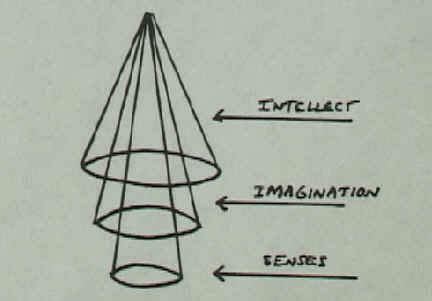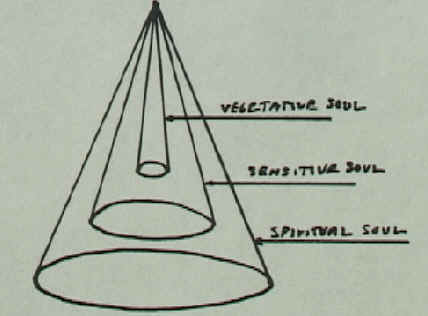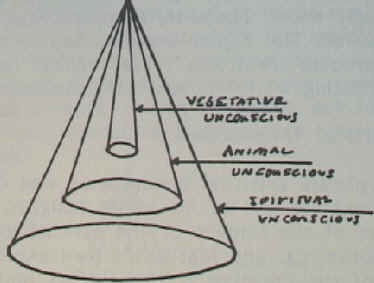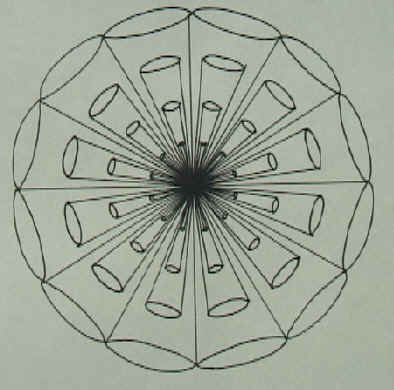CHAPTER 12: BODY, SOUL AND THE SPIRITUAL UNCONSCIOUS
Body and Soul
Virtual Presence
Maritain's Diagram
The Spiritual Unconscious
The Sympathy and Symphony of the Forms
CHAPTER 12:
BODY, SOUL AND THE SPIRITUAL UNCONSCIOUS
The ultimate test case for any conception of matter is how it explains the relationship between the body and the spiritual soul. We have already met some of the principles that St. Thomas employed to explain this relationship. One of them, the unicity of the human substantial form, embroiled him in a great deal of conflict before and after his death. (1) Unlike some of his contemporaries, he insisted there were no distinct vegetative or animal souls that remained after the infusion by God of the spiritual soul. If vegetative and animal souls remained formally present, he argued, then the unity of the human being would be destroyed, for the substantial form is the principle by which something exists and acts, and if something had two such principles, it would be two beings.
But this does not mean that we have to conceive of the human soul as directly informing prime matter in order to safeguard the unity of the human being. Norbert Luyten and Norris Clarke have already pointed out the role that the Thomist idea of virtual presence plays in such a case, and we have seen a concrete example of it in Maritain's description of the development of the embryo. The vegetative and sensitive souls are retained in a very real way, but virtually, not formally. We will have to look more closely at this in a moment. But first we need to examine a radical Carlo-like view of the relationship of the body and the spiritual soul.
If matter is but a potency to substantial existence, why can't we say that the human spirit itself, since we are calling it a spiritual being in potency, possesses matter as a dimension of its own being? Then matter would spring forth as an expression of the lack of intensity of the being of the human spirit. Then there would be no body as an independent principle, but only the human spirit as manifesting itself as a body. Then the body would be the human spirit in its low intensity of being as a spiritual form expressing itself in matter, space and time. Wouldn't this be an explanation for St. Thomas saying that the body doesn't contain the soul, but the soul contains the body? Then our souls exist with a capacity to exist, which is matter, itself, and the whole of material creation is like a rainbow manifesting this potentiality of the human spirit in matter, space and time.
There is a certain seductiveness to this view. But if we embraced it, we would be open to the objections of those who felt - mistakenly, I think - that Carlo had eliminated any positive reality to essence and to matter, and we had just done the same to the human body and, indeed, to all material creation. There are significant flaws in such a radical reduction of body to soul. The human spirit does possess a very basic kind of potency, for it is the only spiritual form which does not immediately activate itself. But this is not the potency of matter which St. Thomas described as a potency to place, or a potency to substantial existence. The human soul as a spirit does not possess that kind of potency, and thus, does not have matter as part of its intrinsic makeup. It has existence above the critical threshold that divides matter and spirit so it can never lose it. It does possess a passivity of its faculties, and thus, in a very real way, of its being as a spirit. And so, pushing our language a bit, we can say it is a spiritual being in potency, but this potency is not the potency of matter, but more precisely, the potency of the human faculties like the intellect and will.
Matter, therefore, cannot be directly reduced to the human spirit as a negation or lack of intensity of the spirit, itself. Matter in the sense of material creation has a wonderful richness and beauty to which we must give a positive meaning. It is a certain expression of what it means to exist. Thus, it cannot be reduced to the potency of the human spirit so that we can say the human spirit, as spirit, manifests itself as body. Material creatures have substantial forms, and thus, substantial existences. The soul does, indeed, contain the body, but not in the sense that the body is only an expression of the soul's capacity to activate itself. In the example of human embryological development the embryo existed with a substantial vegetative soul, and then, with a substantial sensitive soul before it existed with a spiritual soul. While these lesser souls could be subsumed in the spiritual soul, they had their own positive reality.
These clarifications still leave us very far from the kind of dualism that has dominated so much of modern thought, and is now passing from the scene. Joseph Donceel in an article, "Immediate Animation and Delayed Hominization," gives several examples of this anti-dualistic trend in modern Catholic thought.
Edward Schillebeeckz, for example, writes: "Man is not a closed interiority which afterwards, as in a second stage, would incarnate itself in the world through bodyliness. The human body as such belongs indissolubly to man's subjectivity. The human I is essentially in and with the things of the world. He is with himself, he is a person only when he is with other things, especially with other persons... The body does not refer to a soul which lies behind it, it is not a sign of the spirit, but this interiority itself made visible." (2)
And Karl Rahner asserts: " ... that which I experience as the bodyliness of a man is already the reality of the soul, extraposed in that mysterious something, which we know only from metaphysics, which the Scholastic, Thomistic philosopher calls prime matter. The body is already spirit, considered in that aspect of its self-realization in which the personal spirit gives itself away in order to encounter directly and tangibly that which is distinct from it. Hence corporeity is not something which is added to spirituality, but it is the concrete existence of the spirit itself in space and time." (3)
These passages stand in rather strong contrast to some of the ways in which the body-soul relationship was expressed by earlier Catholic thought. Even the great 19th century dogmatic theologian, Matthias Scheeben, could write: "The material body, which in itself is a mass without unity, life, or movement, is held together in coherence, endowed with life, and moved by the spirit as the principle that unifies, animates, and moves. But by its union with matter the spirit forfeits Its purely spiritual independence to a certain extent, and even incurs a sort of slavery to matter. Matter prevents the spirit from beholding itself in its spiritual essence, and in general from enjoying the intuition of purely spiritual things. It forces the spirit to direct its spiritual activity to objects on hand within the realm of matter, to things of sense, yet does not thereby upset the independence and spirituality of this activity." (4)
Just how, then, should we conceive the relationship between the body and the soul? The soul does not immediately grasp its own nature in knowledge and love. But this is not because its union with the body prevents it. Quite the contrary. The human soul is united to the body precisely so it can activate and develop itself. We could say that its passivity and potency allow and demand that it be united to the body.
Let's return to the question of virtual presence. When in the process of the development of the human embryo the vegetative soul is replaced with a sensitive one, and it, in turn, is replaced by a spiritual soul, the previous soul cannot remain as a substantial form, i.e., as the very principle by which the being exists and acts. But it can and does remain virtually. Its whole being remains though being is not a good word - but stripped of its former autonomy. It is taken up into a larger and deeper being, and it exists within that new being with the existence of that being. If substantial change in general can be looked at as a movement from one mode of being to another within the context of existence, then virtual presence means the subordination of existence and action of one being to another. Material natures, because of their fundamental potency to substantial existence, can be subsumed by other material beings and live a higher and deeper life in virtue of that subordination. Lower forms become animated from within by higher forms because not only are both principles of existence, and driven to achieve their own natures, but they are also driven to surpass their own natures by subordinating themselves to other beings so that existence, itself, as it were, can be served in a higher way. Ultimately the existence that is to be served is that of the human soul. The universe exists in the simplest forms in the very beginning of time. This is not an accident, but an expression of the intrinsic nature of matter. Elementary particles serve atoms which, in turn, serve molecules, which serve living bodies, and so forth. But it is only in this way that the higher beings can exist, and thus we can say that the lower material beings exist for the higher ones, and the whole universe exists for the human soul, as St. Thomas indicated.
In 1952, Maritain gave the A.W. Mellon lectures in the fine arts at the National Gallery of Art in Washington, D.C., and strange as it may seem, he provided there a way for us to draw together many of the metaphysical themes we have been seeing in these last chapters. (5) His help comes in the form of reflections on the emanation from the human soul of its various powers.
"As soon as the human soul exists, the powers with which it is naturally endowed also exist, of course, though with regard to their exercise, the nutritive powers come first... and then the sensitive powers, and then the intellective powers. But at the very instant of the creation of the soul, there is an order - with respect not to time but to nature -in the way in which they flow or emanate from the essence of the soul. At this point St. Thomas states that with respect to this order of natural priorities, the more perfect powers emanate before the others, and he goes on to say (here is the point in which I am interested) that in this ontological procession one power of faculty proceeds from the essence of the soul through the medium or instrumentality of another - which emanates beforehand. For the more perfect powers are the principle or raison d’Ítre of others, both as being their end and as being their "active principle," or the efficacious source of their existence. Intelligence does not exist for the senses, but the senses, which are, as he put it, "a certain defective participation in intelligence," exist for intelligence. Hence it is that in the order of natural origin the senses exist, as it were, from the Intellect, in other words, proceed from the essence of the soul through the intellect.
"Consequently, we must say that imagination proceeds or flows from the essence of the soul through the Intellect, and that the external senses proceed from the essence of the soul through imagination. For they exist in man to serve imagination, and through imagination, intelligence." (6) And he draws a diagram to illustrate this process of emanation.

We will return to this diagram in a moment. For now it suffices to see that the intellect gives birth to the imagination which, in turn, gives birth to the senses, and all this is quite the opposite of how we tend to imagine it, for we suppose that the imagination builds on the senses and, in turn, is the foundation for the intellect. This diagram actually illustrates the idea of virtual presence very well, and how the soul contains the body. When the vegetative soul is replaced by the sensitive soul which, in turn, is replaced by the spiritual soul, each succeeding soul is wider and deeper than what preceded. Each soul lives, as it were, within the next, not formally but virtually. We can, therefore, reformulate Maritain's diagram as follows:

We can see that the substantial unity of the human soul is preserved. Maritain indicated this when he said: "For the more perfect powers are the principle or raison d'Ítre of others, both as being their end and as being their "active principle," or the efficacious source of their existence."
Some supplementary clarifications are necessary, as well. The lower powers as in Diagram 1, or the lower forms or souls, as indicated in Diagram 2 are, indeed, subordinated to the higher ones, but this deprivation of autonomy is compensated for by their existing in a higher way in virtue of their virtual presence in the higher form. The human imagination, for example, because of its animation from within by the intellect, has a different and more refined character than a purely animal imagination that is not animated in that way.
The transformation of the lower power, or soul, is a transformation in root, or principle, but it is not yet an actually achieved transformation. This animation of the lower by the higher has as its ultimate purpose the activation and realization of the higher, which is precisely why it has subsumed the lower as the seed of its own realization. The human intellect, for example, is in potency, and needs the senses and imagination in order to actually know. There is, then, a certain symbiosis in the universe. The higher beings subsume the lower, and in the process transform them and lift them to a higher level of being while transforming themselves.
The phrase spiritual unconscious was coined by Maritain to express one of his major insights, an insight that grew out of the impact of the psychological discovery of the unconscious, and Maritain's own explorations of the nature of the creative process in art and poetry, as well as the subjective requirements of metaphysical insight. (I have explored in detail the genesis of this idea in Maritain's thought, and the primordial role it plays in it in Mysticism, Metaphysics and Maritain.)
Just what this spiritual unconscious means is best expressed in Maritain's diagram that we have just been looking at. The original diagram was more complicated than our version of it and looked like this:

The bases of the cones represent where those cones enter into consciousness. We see a conscious world of concepts and reasoning, another of images, and a third of sensation. The vast volumes of the cones represent the unconscious. There is not only a Freudian unconscious of repressed material, but a spiritual unconscious - a modern equivalent to the center of the soul known by the medieval mystics and philosophers, but not formally reflected upon.
If we redraw our adaptation of Maritain's diagram it will now took like this:

The volume of the largest outer cone, which represents the human soul, can be called the
spiritual unconscious in a special way. The base of the cone is the conscious world of
intellect and will, which is now seen to rest on a whole inner universe.
But what has this to do with our search for the philosophical foundations to nonlocality, morphic resonance and synchronicity? That goal seems to have been lost under a relentless flow, however necessary, of Thomist philosophy. Yet, in actual fact, with this diagram we have begun to arrive at our goal. In virtue of our spiritual souls informing our bodies, in virtue of the spiritual unconscious which in some mysterious way informs our bodies and thus in some way the universe, we can be said to be united with the whole universe. It has given birth to us, and we have taken it into ourselves. The universe, in virtue of matter, is a communion of beings, and the human soul is the sea in which they swim.
The Sympathy and Symphony of the Forms
This last diagram illustrates the hierarchy of material beings and their interconnectedness. But action follows being. Therefore, there must be a hierarchy of action, and even, we could say, a hierarchy of the actions that lead to interconnectedness.
Material beings have that special potency we are calling matter that is the root that allows their interconnectedness. They are, in a certain way, in potency to each other in their very being. Their characteristic action is on one hand their own perfection, and on the other, substantial change, which is brought about by efficient causality. Substantial change can be looked at as how material beings communicate with each other. It is a communion of entitative beings. One thing literally becomes another and ceases to be what it was. One thing causes, or gives, being, or takes away being from another. In short, material beings physically interact with each other. They transmit and receive their very forms to and from each other by a literal information that we have come to know under the heading of virtual presence and substantial change.
The human form shares in this kind of action and communion to a certain degree because it informs the body and literally takes possession of the previous forms, i.e., becomes the substantial form of that living organism. But the human form is also a spiritual being. It has that fundamental relationship and openness and receptivity to its own substantial existence that will never allow it to lose that existence. The literal information that is the way of communion among material forms is not suited to a spiritual being. The human soul, to the degree that it rises above matter, shares in another kind of information.
Literal entitative information means that one material creature becomes another at the price of its own substantial form and existence. In this new way of information one being becomes another precisely as other without losing its own being. Therefore, this becoming, this new kind of existence, cannot be a question of entitative existence. Here we return to the esse intentionale, or intentional existence, that we saw Norris Clarke talking about in Chapter 10. This is the kind of existence that must be posited if genuine knowledge exists. The word knowledge has become so shopworn that it hides from us the fact that it is a kind of superexistence in which the knower becomes the thing known. When we know a stone or a tree, they are not entitatively present in our minds, yet if they were not somehow truly present in their very being, we would have no genuine knowledge of them whatsoever.
"Another kind of existence must, then, be admitted; an existence according to which the known will be in the knower and the knower will be the known, an entirely tendential and immaterial existence, whose office is not to posit a thing outside nothingness for itself and as a subject, but, on the contrary, for another thing and as a relation. It is an existence that does not seal up the thing within the bounds of its nature, but sets it free from them." (7)
We met another kind of intentional existence when Maritain described how the chisel of Michelangelo was directed by the virtue of his art which passed through it - not entitatively - and directed its motion that led to the creation of the statue. There is nothing in the chisel as a physical object that can account for the beauty of the statue. A higher causality, "a causality superordered to it," moves through it, which is a certain intentional existence which, while it is not the esse intentionale of intellectual knowledge, is akin to it. Maritain writes:
"We think it would be of great interest to philosophers to study the role that esse intentionale plays in the physical world itself, wherein there undoubtedly arises from such existing, that sort of universal animation whereby motion puts into bodies more than they are, and colours the whole of nature with a semblance of life and feeling undoubtedly derived from it." (8)
In virtue of its informing power the human soul literally and entitatively informs the body, which is the finest and final fruit of the process of evolution. Thus, it informs and animates from within the elements, the molecules, and the vegetative and animal dimensions of the body. But the human form, precisely as a spiritual form, has an even more intimate way of communing with material forms. It can know them. In virtue of its spiritual nature expressed in its agent or illuminating intellect, which is the very spiritual power of the soul, itself, the human spirit bathes material beings in a spiritual light and allows them to exist for it as objects to be known, to exist with an intentional and relational existence which allows it to know them as they are.
There is, therefore, an information or communion, or sympathy of the forms in virtue of which the human soul literally informs material form. But there is a more powerful information in which the material forms become present to the soul in their intentional existence so that they can become truly one with it by being known by it. Both of these informations are driven by the same goal, which is the creation and activation of the human universe.
These long metaphysical excursions that have occupied us in Part IV have brought us to
the foundations of a Thomist view of the interconnectedness of the universe, and now we
are faced with the challenge of returning to our three scientific themes to see if these
tools which we have fashioned can help us penetrate into them more deeply, and whether
these explorations, in turn, can help us refine our philosophical tools.

A final diagram will prepare us for an attempt to create a philosophical explanation of
nonlocality, morphic resonance and synchronicity.
The center of the circle represents the first moment of creation. Each circle of cones of the same size represents a distinct stage in the evolution of the universe. First comes the basic elements, then vegetative life, animal life, and finally, human beings.
If we limit our explanation of the universe to material and efficient causes, our explanation will be deficient. We will be compelled to try to explain the more complex and conscious stages of the universe by its more elementary ones. The end result will be a reductionism that cannot take account of all that is most distinctive about it. The stone is made the explanation of the cathedral. Biology and psychology are nothing but physics in disguise. The intricate order the universe manifests is caused by random mutations and the survival of the fittest.
This kind of universe, far from being scientific, is a distortion of what is actually in front of our eyes. Posit formal and final causes and the whole picture changes. The universe from its very beginning is precisely a universe, and a human universe. It is of the nature of all material beings to be related to each other and to come together to create a whole. The higher beings emerge from the lower, who then become virtually present within them, but this emergence is of a more complex and conscious whole that cannot be fully explained in terms of the elements that make it up.